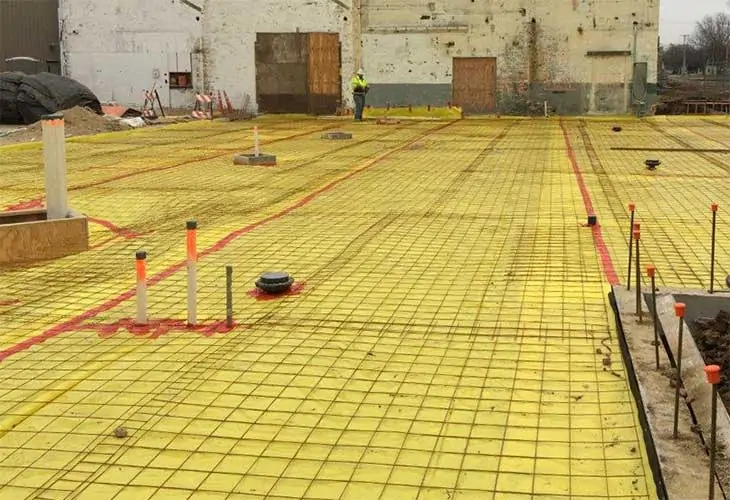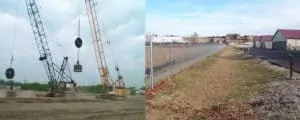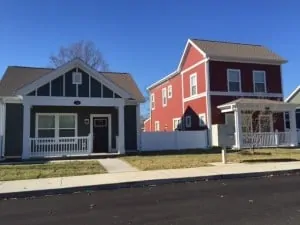


Vapor intrusion is a regulatory hot button gaining traction on states’ radar nationwide. This is driven by a growing understanding of how vapors travel through the soil into structures, posing health risks to occupants, coupled with research showing volatile vapors can be problematic even at very low concentrations.
As in California, conservative assumptions by regulatory agencies call for careful due diligence during the assessment process. These salient concerns recently brought a real estate developer in Monrovia to seek a professional engineer.
The client plans to convert a commercial property to residential use. But before moving forward, it needs to assess potential environmental issues associated with the property. That’s where SCS comes in, drawing on its concrete knowledge base in geology and chemistry—and leveraging its grasp of regulatory requirements.
The work in Monrovia entails a detailed soil vapor assessment, looking for volatile organic compounds (VOCs); the discovery at this site came as little surprise to Julio Nuno, Senior Vice President, and Project Director, as these constituents are often found during evaluations of this kind.
Assessing for VOCs
In this case, the soil contained eight VOCs, some at non-compliant levels. The good news is, after an extensive, multi-step vetting process, Nuno and his team came up with a relatively inexpensive solution to tackle a potentially daunting problem.
“As part of the soil vapor assessment, we compare concentrations we find on-site to screening levels established by the Department of Toxic Substances Control. We often see levels in exceedance of regulatory thresholds, particularly in industrial areas with releases that can travel from groundwater to soil into the building through the slab,” Nuno says.
Most prominent at the Monrovia site were two chlorinated compounds that have been used as solvents in industrial applications: tetrachloroethylene, also called PCE, and trichloroethene, or TCE. PCE is commonly present in industrial settings and communities as drycleaners widely and routinely used the chemical for decades.
Nevertheless, the work begins even before confirming VOC levels and other specifics around these compounds. The first step is a Phase I Environmental Assessment looking to see if past use of the property or surrounding property may have left a significant environmental impact. The SCS team discovered the adjacent property had a release of VOCs they identified as a ‘recognized environmental condition,’ meaning it needs further evaluation using a Phase II to determine if vapors could migrate onto the client’s property.
During the Phase II Environmental Assessment –the collection of soil and soil vapor samples –the SCS team gets even more specific, determining what’s present, specific locations, what degree of contamination, and what these findings mean for redeveloping the property and its final use.
“We confirm subsurface concentrations and if they exceed state screening levels, and if the site represents a potential risk for future residential use. The information informs our possible solutions to mitigate any migration of certain VOCs into the building and the indoor air,” Nuno explains.
Redevelopment Goals – safety and cost containment
Safety comes first, but containing project costs is a priority, which comes down to knowing design options, how to piece components together with both function and economics in mind. At this site, achieving safety and controlling costs centered largely around looking at the mandatory infrastructure– a ventilation system for a planned underground parking garage to prevent accumulation of carbon monoxide and other vehicle exhaust emissions.
“We knew the underground parking would require a ventilation system. It makes sense to look at the parameters associated with that design to verify if it serves dual purposes to ventilate the garage and mitigate the potential for VOCs to enter the building,” Nuno says.
By studying air exchanges that would occur, the number of times replacing air-containing pollutants with cleaner air per hour, Nuno gets his answer. “We determined that a second, separate system would not be necessary for sufficient ventilation; the assessment enabled us to confirm vapors would not travel into the residential portion of the building.”
The client can save $50,000 to $75,000 in capital expenses upfront while achieving their safety goals and avoids ongoing operations and maintenance costs for added infrastructure.
An added layer of protection
Identifying the issues for site developers and their tenants, then plotting the best course of action to ensure safety and regulatory compliance takes experience and knowledge. SCS devises a soil monitoring plan, alerting developers of indications of potential contamination to the soil, of odor, or anything unusual that could suggest an environmentally adverse condition. The plan advises on how to respond should there be an unexpected condition adding a further protection layer.
“It’s essential that an engineer understand the applicable federal, state, and local standards for completing assessments, as well as understand regulatory stipulations. You must also know the variations in those stipulations to effectively design a sustainable plan,” Nuno says. “In Monrovia, we comply with the Department of Toxic Substances Control requirements, the requirements of the Los Angeles Regional Quality Control Board, and others. Each has specific stipulations for evaluating each contaminant. So, we stay on top of which rules apply to which location,” he says.
Nuno has submitted a draft report for review by his client and its legal counsel; he’ll meet with them to discuss findings and explain their meaning. SCS includes an executive summary, explaining in plain language what is salient; often, a backup report includes thousands of pages. “It’s a lot of complex information, so we work on the language,” Nuno says.
“It’s important to paint an accurate picture and use terms that all parties, whether the client, investors, or other stakeholders understand. These redevelopments are major projects with many due diligence considerations. We want to provide accurate findings and recommendations that the client and their advisors can digest to help them with their decision making.”
More resources:
SCS Engineers Vice President Ashley Hutchens is now the Environmental Services Director for its Long Beach and Las Vegas operations. Besides managing her current projects and clients, Hutchens will manage the environmental professionals and technicians in each city. She is responsible for allocating resources for business development, project management, and coordinating activities with other SCS offices nationwide.
“Ashley’s proven capabilities solving environmental challenges for industries will serve our Long Beach and Las Vegas clients well,” said Julio Nuno, SCS Senior Vice President.
Hutchens has 18 years of experience in property evaluation and due diligence, site assessment, characterization, remediation; vapor intrusion assessment and mitigation; and hazardous waste management. She has led hundreds of projects, including all phases, from the development of cost estimates for site assessment, mitigation, and remediation, to groundwater monitoring and sampling, preparation and review of final reports, interfacing with regulatory agencies, and management of all aspects of projects, staff, and various subcontractors.
SCS Engineers’ environmental solutions directly result from our experience and dedication to solid waste management and other industries responsible for safeguarding the environment. For more information about SCS, please visit us at www.scsengineers.com, or contact .
Perfluoroalkyl and polyfluroalkyl substances (PFAS) and other emerging contaminants are becoming increasingly important for real estate transactions. Several states have adopted or proposed health guidelines or Maximum Contaminant Levels (MCLs) for PFAS in their state. States with adopted limits include CA, CT, CO, MN, NC, NH, NJ, and VT; and states with proposed limits include IL, MA, MI, and NY. You can track bills by state here.
The Wisconsin Department of Natural Resources (WDNR) and the Environmental Protection Agency (EPA) are focusing their attention on these contaminants. The WDNR recently issued letters to more than 3,000 responsible parties listed with open cases on the DNR’s Bureau for Remediation and Redevelopment Tracking System (BRRTS) requesting they review PFAS use at open sites. Read a sample of the DNR letter.
With WDNR’s increasing focus on PFAS, a lack of sufficient due diligence, which includes evaluations for PFAS, could lead to significant additional liability for property purchasers, developers, and lenders. In addition, a lack of sufficient assessment could lead to a delay in case closure even after responsible parties have addressed all other contaminants and potential exposure pathways at a site. A sufficient assessment for PFAS will depend on site-specific factors and should carefully consider the associated risks and liabilities.
For real estate buyers, owners, developers, lenders, brokers, and contractors the potential presence of PFAS at a property presents significant liabilities that need to be incorporated into due diligence procedures and safe work plans. The investigation and remediation of sites with PFAS contamination can be expensive, and the WDNR is working to define enforceable cleanup goals for soil and groundwater.
Resources:
About PFAS
PFAS are often referred to as “forever chemicals” due to their inability to be broken down in the environment. Due to the very high toxicity of PFAS, the proposed groundwater standard is extremely low – in the parts per trillion, which is more than 100 times lower than the groundwater standards for other well-known toxic contaminants such as benzene from gasoline or tetrachloroethylene commonly used at dry cleaners and industrial facilities.
PFAS are found in a wide variety of products, including nonstick coatings (e.g., Teflon), water-repellent coatings used on clothing and food packaging, fume suppressants, and firefighting foams. Potential sources of PFAS include many types of manufacturing and processing facilities, locations where firefighting foams have been used, metal plating facilities, wastewater treatment plants, and many more.
PFAS systems can treat and clean sources and remediation solutions by environmental engineers can bring properties back to life; safe to build and live on.

Historic fill is common on properties that were once rural and have become prime redevelopment sites as communities expanded. The fill may include contaminated materials like foundry sand, ash, demo and construction debris, and even municipal waste. In the past, these materials were used to fill wetlands or change the grade of the property before initial development. Today regulations have evolved, and state agencies require property owners to manage these materials appropriately during redevelopment. Also, particular types of historic fill are often not robust enough to structurally support your new building.

There are many different kinds of fill materials – each with different physical properties and different potential contaminants. Knowing what is on your property before you start designing the site layout, and certainly, before you start digging, will help you plan your project to save time and money, and to receive state agency approval.
Before You Buy
The more you know about the property and the earlier you know it, the better prepared you will be to make decisions about how best to protect yourself from potential environmental liabilities and prepare for the environmental and geotechnical issues that historic fill can cause. Since every property is unique, the first thing you need to do is gain a thorough understanding of the property’s history and past use. Invest in a comprehensive Phase 1 Environmental Site Assessment (ESA). Consider it a starting point for clues about the possible types and amounts of historic fill which may be present on the property.
If the results of the Phase 1 ESA warrant it, conduct a Phase 2 ESA and geotechnical study to collect soil, fill, groundwater, and soil vapor samples. The Phase 2 ESA and geotechnical studies will help you understand if fill and contaminants are present and the best options for addressing them during the development planning stage.
Historic fill on a property is no longer the impediment to development that it once was. Take these steps to get ahead of potentially contaminated historic fill, and keep your project on time and budget.
By testing early, performing a proper geotechnical evaluation, and incorporating design adaptations where needed, you can successfully develop projects with historic fill within your schedule and without breaking your budget.
SCS professionals are available to answer questions or concerns you may have pertaining to commercial, residential, or private development on brownfields – we provide remediation, brownfields, and Environmental Due Diligence services nationwide. Contact or one of our experts.

Ray Tierney, PG, is a Vice President of SCS Engineers and one of our National Experts on Sustainability. He has 30 years of experience in environmental and sustainability engineering and has helped a wide range of organizations control and reduce their legacy environmental impacts and liabilities, lower their costs, obtain grants and permits to expand, and implement cost-saving practices. Ray serves the Midwest region and projects throughout the U.S.
JohnTabella, PG, LEED AP®, is SCS Engineers National Expert for Environmental Due Diligence and for Federal Services. In this capacity, he oversees all aspects of environmental services opportunities and projects primarily throughout the eastern seaboard and supports on opportunities and projects throughout the U.S.
Floyd Cotter specializes in solid waste management projects. His project work involves all areas of solid waste management including planning, permitting, transportation, landfill design, construction, and monitoring. Floyd is also experienced in general civil engineering, construction oversight, environmental site assessments, closure and post-closure plans, and permit and contract document preparation. Floyd is located in the Central region.
Randy Bauer has nearly 3 decades of experience conducting environmental site assessments, subsurface investigations, groundwater monitoring programs, soil and groundwater remediation, and geotechnical investigations at industrial hazardous waste and solid waste facilities. Randy is available to answer questions on the western seaboard.
When Virtual Care Providers, Inc. (VCPI) set out to sell their company, David Bartlett, VCPI Chief Financial Officer, thought they had their environmental due diligence squared away. “We did our due diligence in 2006 when we purchased the property,” said Bartlett. “Unfortunately we discovered that the original Phase 1 Environmental Site Assessment (ESA) missed some potential issues.”
To complete the sale, VCPI needed to conduct a new Phase 1 assessment. That’s when David hired SCS Engineers to help VCPI through the environmental due diligence process. “When Ray Tierney and his team went through the Phase 1 process, they discovered there was something there. The original Phase 1 from our prior consultant missed some things.”
Long before it was a data center, the property owner used hazardous chemicals in their manufacturing process. As part of that process, they stored some of the chemicals on the exterior of the property. Although the chemicals had been removed long ago, some of them had spilled onto unpaved areas. While VCPI had no knowledge of the property’s prior use when they bought it, SCS Engineers uncovered detailed records and photos of the chemical storage in state agency files.
“Of course the parties involved in the sale were concerned about these past issues and the impact they could have on the sale and ongoing use of the property,” Bartlett confirmed. “We initiated a Phase 2 to gain clarification. Then we worked with the Wisconsin Department of Natural Resources (WDNR) to get the property closed.” In the end, no active remediation was required. However, these steps were necessary to get the WDNR to grant site closure.
“Being in this situation was painful,” Bartlett admitted. “But SCS Engineers’ integrity shone through in every step and was absolutely critical. Everyone that I worked with at SCS Engineers gave us peace of mind that the steps we took weren’t just to pad pocketbooks. Ray’s team showed us how each step in the process was necessary to get us past the problems, on to resolution, and on to the successful sale of our company. I completely trusted the information SCS Engineers gave us.”
“Without Ray and his team, we never would have been able to expedite the process. We simply didn’t have the connections or the relationships with the WDNR to move it along. SCS Engineers’ familiarity with the process and relationships with the WDNR really helped speed us to resolution, which allowed us to move forward with the sale of our business.”
“I don’t know what would have happened or how long it would have taken without SCS Engineers’ expertise. The depth and breadth of their knowledge shed light on issues I wasn’t aware of. Not only did Ray’s team help us uncover the issues, they gave us a plan to determine the extent of those issues and helped show us how to move past them. Their expertise, knowledge, and guidance were critical.”
VCPI kept the sale of their business on track and closed on December 22, 2016.
Thank you for your kind letter, Mr. Bartlett. We were happy to help resolve the issues leading to the sale and the safe ongoing use of the property by its new owner.